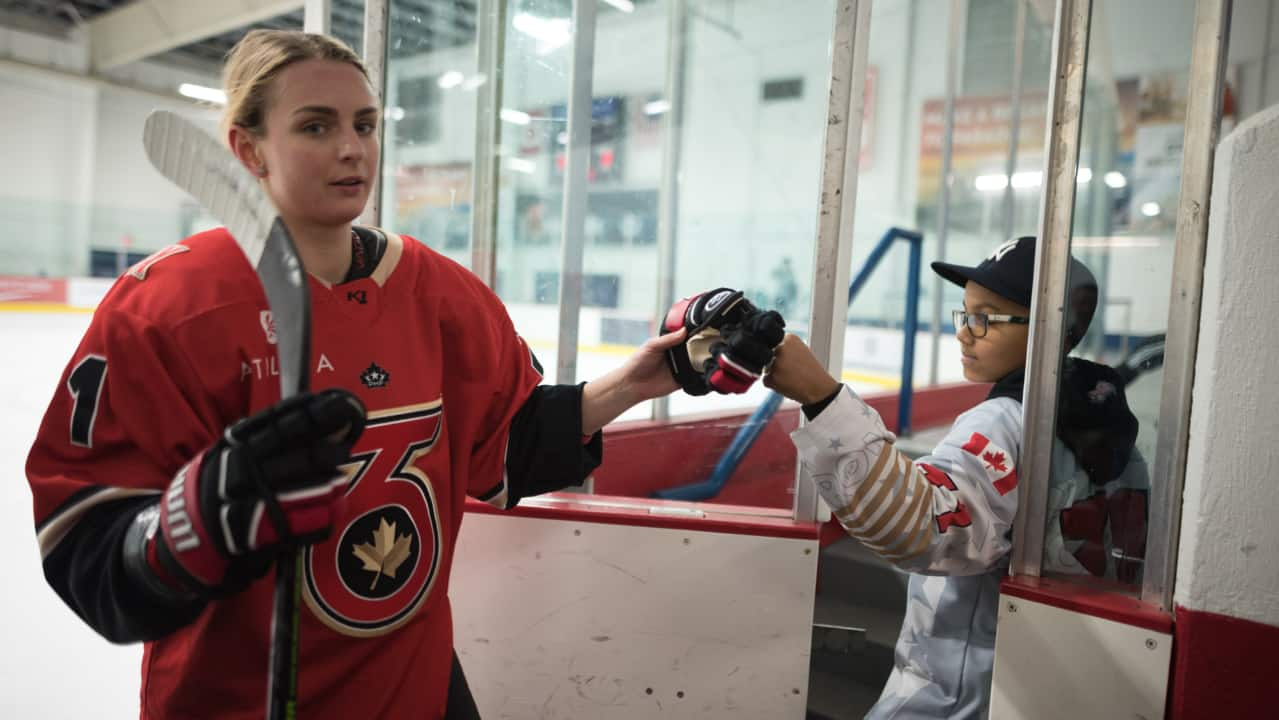Women's professional hockey finally has a unified league. Now what?
Marie-Philip Poulin, right, and Kristen Richards, left, race for the puck during a Dream Gap Tour game in 2021. The PWHPA will begin playing in a new, unnamed league next January. (Jeff McIntosh/The Canadian Press)For at least four years, women's professional hockey players advocated vociferously for one unified league.About one week ago, it finally happened when Mark Walter, a co-owner of MLB's Los Angeles Dodgers, announced his company bought out the Premier Hockey Federation (PHF) and would cease its operations. Days later, the Professional Women's Hockey Players' Association (PWHPA) ratified a collective bargaining agreement (CBA) with the Walter group to begin a new unnamed pro league in January 2024.There will reportedly be six teams evenly divided between Canada and the U.S., with player salaries ranging from $35,000 to $80,000 US.Included in the CBA is health insurance, a retirement plan, commercial rights, maternity leave and much more.Professional Women's Hockey Players' Asso

For at least four years, women's professional hockey players advocated vociferously for one unified league.
About one week ago, it finally happened when Mark Walter, a co-owner of MLB's Los Angeles Dodgers, announced his company bought out the Premier Hockey Federation (PHF) and would cease its operations. Days later, the Professional Women's Hockey Players' Association (PWHPA) ratified a collective bargaining agreement (CBA) with the Walter group to begin a new unnamed pro league in January 2024.
There will reportedly be six teams evenly divided between Canada and the U.S., with player salaries ranging from $35,000 to $80,000 US.
One hard part is over. The next one, however, is just beginning.
Experts say among key next steps in ensuring the league's success are identifying the correct markets, fairly allocating players across the league, negotiating a fair media rights deal and securing sponsorship. A deal with the NHL could be beneficial, they say, but only on certain terms.
Laurel Walzak, who was chair of the Canadian Women's Hockey League (CWHL) board when it folded in 2019, told CBC Sports the new vision for women's hockey is promising — especially with the backing of Walter, who also co-owns English Premier League club Chelsea and whose estimated net worth, per Forbes, is $5.3 billion.
"The way that it was done with the media rights deal before and the sponsors before and events before and all that stuff like that, it can't exist that way. If it exists that way, then it's going to fail," she said. "I don't believe for one second that it'll exist that way anymore because so much has changed since then."
Identifying markets
Both Walzak and Ann Pegoraro, the chair of sport management at Guelph University's business school, said the league's initial business model, in which it owns each of the six clubs, was intriguing.
Pegoraro said laying the groundwork equally would be crucial in the league's initial buildup.
"But the idea that they can sell their franchises off, provide future revenue streams and build out the league by adding new franchises at the same time, I think that's got to be the end goal where there would be individual franchise owners and the ability to expand across North America," Pegoraro said.
In the CWHL's final season, teams were placed in Toronto, Montreal and Calgary, in addition to Markham, Ont., Worcester, Mass., and Shenzhen, China.

A clustering of teams in the northeast might make more sense to limit travel costs and concentrate the hockey to its biggest markets. The Associated Press has reported Toronto, Montreal, Ottawa, London, Ont., Washington, Pittsburgh, Philadelphia, Boston and New York are all under consideration.
Stan Kasten, the Dodgers president who's considered a point man in getting the new league off the ground, told The Canadian Press his aim is to go public with a league name and logo, team locations and a game schedule in the next two months.
Wherever the league winds up, Walzak said it is important to keep fans top of mind — even those out of market.
Within the cities the league chooses, Pegoraro noted they should pick arenas with growth potential.
"I think if you put them into decent sized arenas that are hockey specific and good locations, I think that there is a demand. We saw that the women's games in the Olympics, the world Championships drew huge audiences on television. So there is a group that wants to watch these games," she said.
'Short-term pain, long-term gain'
Which is also where the media rights deal comes in. As Walzak notes, it benefits no one to play on Sunday mornings or to only broadcast big games. Instead, there needs to be a fulsome agreement where every game is available, whether it's on traditional broadcast TV or streaming.
"I don't know if it's going to be traditional linear. There might be something similar to what's done with MLS with an Apple TV deal. Who knows?" Walzak said.
"I think that they're going to have to do things differently because, if you think about it, nobody in North America to date, besides the big games, really invested heavily in broadcast rights for CWHL or PHF."
Some PHF players were scheduled to make up to $150,000 next season.
"For the short-term pain, there's going to be long-term gain and there's going to be sustainability in this league that that will be in perpetuity similar to what's going on with the WNBA, how finally after so many years it's taken off, and NWSL is starting to take off," Walzak said. "Now is the time for women's sports."
Still, there may have to be some sort of mending of fences between the PWHPA and PHF.
"It looked like, wow, [the PHF] really turned the corner and now potentially a good portion of [players] lost jobs. And I think that that's an immediate hit on the game," Pegoraro said.
WATCH | Women's pro hockey struggles to gain foothold:
Fair dealings
Asked what she may advise the new league based off her CWHL experience, Walzak warned against sponsorship deals that provide little or no value.
"I think the stakeholders, sponsors need to pay up. So the old deals of 'I'll give you jerseys to play in' — no, where's the money? Plus we'll wear your jerseys. Because that's part of the deal is you want all of the people to be wearing your jerseys. OK, great. So that's going to cost you X amount of dollars."
It's the same principle that should be employed in talks with the NHL, which has said in the past that it will support women's hockey when there's one unified league.
But while the new league should be able to operate on its own, it will be competing with the NHL for eyeballs over the winter months.
"Whether they need an investment from the NHL or a specific relationship to attach to existing franchises, I'm not sure they need that at this point," Pegoraro said. "But I think they need some sort of relationship that will allow them to cross-promote and support each other without necessarily the men's league sort of just dominating all the time."
Pegoraro added that the pitch to all potential partners should be to look at the NWSL's Angel City FC, which paid a reported $2-3 million franchise fee before being valued at over $100 million before ever playing a game.
"This is the moment, this is the time we're seeing huge return on investments. … We know that the only place that you can get that kind of growth and return on your dollar right now is in women's sports."
What's Your Reaction?














